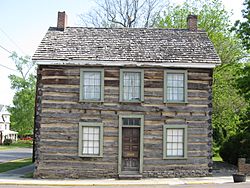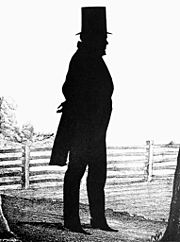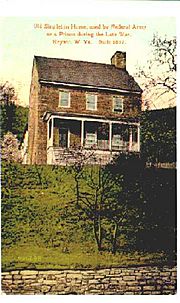Angus William McDonald facts for kids
Quick facts for kids
Angus William McDonald
|
|
|---|---|

Portrait of Angus William McDonald
|
|
| Birth name | Angus William McDonald |
| Born | February 14, 1799 Winchester, Virginia, United States |
| Died | December 1, 1864 (aged 65) Richmond, Virginia, Confederate States of America |
| Buried |
Hollywood Cemetery, United States
|
| Allegiance | United States of America Confederate States of America |
| Service/ |
|
| Years of service | 1817–1819 (USA) 1861–1864 (CSA) |
| Rank | |
| Unit | 7th U.S. Infantry Regiment |
| Commands held | 7th Virginia Cavalry Regiment (CSA) |
| Battles/wars | American Civil War |
| Alma mater | United States Military Academy |
| Spouse(s) | Leacy Anne Naylor Cornelia Peake |
| Relations | 18 children including: Angus William McDonald Jr. Edward Allen Hitchcock McDonald William Naylor McDonald Marshall McDonald Craig Woodrow McDonald Other relations: Angus McDonald (grandfather) Angus McDonald (father) |
| Other work | Military officer, fur trader, lawyer, deputy sheriff |
Angus William McDonald (February 14, 1799 – December 1, 1864) was an important person in 19th-century Virginia. He was a military officer and a lawyer. During the American Civil War, he was a colonel leading the Confederate States Army's 7th Virginia Cavalry.
McDonald also held several important government jobs. He was a superintendent for building the Northwestern Turnpike. He also worked as a commissioner for Virginia in a land dispute with Maryland. He was the grandson of another famous military officer, Angus McDonald. His son, Marshall McDonald, later became a commissioner for the United States Fish Commission.
Contents
Early Life and School
Angus William McDonald was born on February 14, 1799, in Winchester, Virginia. He was the oldest child of Angus McDonald, a well-known farmer. His mother was Mary McGuire McDonald. His grandfather was also named Angus McDonald, a soldier and landowner.
Angus's family had roots in Scotland, the Netherlands, France, and Ireland. When his mother died in 1809, Angus and his younger siblings went to live with their grandmother. They lived at "Glengarry" plantation near Winchester. Around age twelve, Angus went to Winchester Academy. He lived with his uncle, Edward McGuire, while studying there.
Military Academy and Early Army Days
On July 30, 1814, Angus McDonald joined the United States Military Academy at West Point, New York. He was appointed by President James Madison. In October 1814, his father, who was a major in the U.S. Army, died during the War of 1812.
Angus did very well at West Point. He finished his studies in three years instead of the usual four. He became good friends with Ethan Allen Hitchcock, and later named his second son after him.
McDonald graduated on July 17, 1817. He became a third lieutenant in the 7th Infantry Regiment. On April 1, 1818, he was promoted to first lieutenant. He served in New Orleans and Mobile Bay, Alabama. He wanted to serve on the American frontier, but couldn't get a transfer. So, he left the army on January 31, 1819, to work in the fur trade.
Life as a Fur Trader
After leaving the army, McDonald traveled to St. Louis in the Missouri Territory. There, he met many fur traders. He joined the Missouri Fur Company as a clerk. In his first year, he learned several Native American languages. This helped him become a language interpreter.
In his second year, he became a full partner in the company. But the company soon went bankrupt. McDonald then started his own successful trapping and trading business. He worked on the Yellowstone River for three more years. During this time, he met many Native American tribes and their chiefs. One chief was "Tobacco" of the Mandan tribe.
Because he was strong, confident, and brave, Native American tribes called him "Big Knife." McDonald often returned to St. Louis with lots of furs and skins. This earned him a lot of money.
After about four years, McDonald became interested in settling the Southwestern United States. He and ten friends planned to gather emigrants to take over Mexican Texas. They wanted to create a new sovereign state. McDonald returned to Winchester, Virginia, to find people to join his plan.
Law Career and Public Jobs

Before leaving Winchester for Texas, McDonald met Leacy Anne Naylor. She was the daughter of a lawyer from Romney. McDonald decided to stay in Romney and study law instead. In just over a year, he became a lawyer. He opened his own law practice in Romney. He also served as a deputy sheriff for Hampshire County, West Virginia.
McDonald married Leacy Anne Naylor on January 11, 1827. They lived in a log cabin in Romney. This house is now a museum called the Davis History House. They raised their nine children there. McDonald became a well-known lawyer. His successful law practice helped him buy a lot of land in the American West. In 1836, he became the prosecuting attorney for Hampshire County. His son, Angus William McDonald Jr., later joined him in law.
Northwestern Turnpike Superintendent
In 1832, McDonald was chosen to be the state superintendent for building the Northwestern Turnpike. This road is now U.S. Route 50 in West Virginia. He worked under Claudius Crozet, a chief engineer. McDonald was very focused on saving money. This made him unpopular with some people.
For example, he built the turnpike through Joseph Kackley's best farmland. He also wanted to build it through the garden of John Baker White, the Clerk of the Hampshire County Court. White won a court appeal, and the road had to be moved. You can still see this curve in Main Street in Romney today. McDonald was removed from his job on April 5, 1834.

Romney Literary Society
McDonald was an active member of the Romney Literary Society. He also served on the board of trustees for Romney Academy. He was appointed to this role by the Virginia General Assembly on March 25, 1839.
Political Activities
McDonald was not interested in holding political office himself. However, he was very active in supporting political ideas he believed in. He always supported states' rights, even as political parties changed. He was part of the Democratic-Republican Party, then the Whig Party, and finally the Democratic Party.
After his first wife, Leacy Anne, died in 1843, McDonald became even more involved in politics. At that time, Virginia law required citizens to own a certain amount of land to vote. McDonald would transfer land to young men in the Whig Party so they could vote in elections he cared about. This made him many enemies in the opposing Democratic Party. When he asked President James K. Polk for permission to raise a group of volunteers for the Mexican–American War, his request was denied.
Virginia Boundary Commissioner

In 1846, McDonald moved to Hannibal, Missouri, where he had invested a lot of money. He traveled between Virginia and Missouri. In Hannibal, he met Cornelia Peake, who later became his second wife. They married on May 27, 1847, in Hannibal. In 1848, they moved back to Romney, where McDonald continued his law practice.
In 1853, McDonald and his family moved to "Wind Lea" in Paddy Town (now Keyser, West Virginia). This town was along the Potomac River and the Baltimore and Ohio Railroad. McDonald's wife, Cornelia, convinced the Post Office to change the town's name to Wind Lea. Later, it was changed again to New Creek Station after the family left.
The McDonald family then moved back to Romney, and later to Winchester, Angus's hometown. In 1856, McDonald bought a house called "Hawthorne" in Winchester. This house had been owned by Virginia Governor James Wood and George Washington's nephew.
Soon after moving to Winchester, McDonald was appointed by Virginia Governor Henry A. Wise to help solve a border dispute with Maryland. McDonald discovered that Maryland had been using land that belonged to Virginia. In 1859, he told the Virginia General Assembly. They allowed him to go to England to find old records about the border.
McDonald arrived in London in July 1860. He found enough records to prove Virginia's claim. He returned to the United States in November 1860. The border dispute was finally settled in 1910 by the Supreme Court of the United States. The court decided the border between Maryland and West Virginia (which had separated from Virginia) was the south bank of the Potomac River.
American Civil War
Before the American Civil War started, McDonald supported the idea of states leaving the United States. But during his trip to England, he saw how a "united republic" was better than many separate states. When he returned, he again supported states leaving. After Virginia left the United States in April 1861, he went to Harpers Ferry, West Virginia, to join the Confederate States Army.
General Kenton Harper asked McDonald to guard the bridges and river crossings along the Potomac River. McDonald was put in charge of a company that included Captain Turner Ashby. He sent small groups on scouting trips as far south as Washington, D.C.. McDonald realized they needed a special group to map the land. So, he created Virginia's first topographic corps. He was made a captain of cavalry.
7th Virginia Cavalry Command
McDonald became the first colonel to lead the 7th Virginia Cavalry. He formed this group in the spring of 1861. In June 1861, McDonald and his cavalry took control of Romney. But they were defeated by the Union Army in July.
McDonald's 7th Virginia Cavalry fought Union Army forces in the Battle of Hanging Rocks Pass on September 24, 1861. McDonald learned that Union troops planned to pass through the Hanging Rocks gap. He and 26 of his soldiers climbed to the top of Hanging Rocks early on September 24. They were ready for the Union troops. McDonald and his cavalry recaptured Romney that day, forcing the Union Army to retreat.
McDonald had to resign from his command in late 1861 because of severe rheumatism, a painful joint condition. After this, he went to Richmond. He worked as an advisor to the Confederate States War Department. His wife stayed at "Hawthorne" with their children and servants until June 1863. Then, she moved to Lexington, Virginia, to live with McDonald.
Prisoner of War
In July 1864, while McDonald was in Lexington, he was arrested by Union Army General David Hunter. His 16-year-old son, Harry, was also arrested. Harry escaped a day or two later. But McDonald remained a prisoner. He was taken to Cumberland, Maryland, where he was handcuffed and put in solitary confinement. Then, he was moved to a military prison in Wheeling, West Virginia.
In Wheeling, McDonald was treated harshly. He was kept handcuffed in a small "dungeon" cell. He was allowed to have a Bible, which gave him "great peace and comfort."
After his release, McDonald reunited with his children in Richmond. His time in prison had made his health much worse. He had been sick for several years. He planned to return to Lexington, but his health continued to decline. He died on December 1, 1864. His wife arrived the day after he died. McDonald's funeral service was held on December 2 at St. Paul's Episcopal Church. He was buried with full military honors at Hollywood Cemetery in Richmond.
Children
Angus McDonald and his first wife, Leacy Anne Naylor, had nine children:
| Portrait | Name | Birth and death dates | Spouse |
|---|---|---|---|
 |
Mary Naylor McDonald Green | Born December 27, 1827 | Married on April 27, 1852, Thomas Claiborne Green |
 |
Angus William McDonald Jr. | Born May 16, 1829 | Married on February 17, 1857, Elizabeth Morton Sherrard; Married on June 5, 1894, Mary Elizabeth Riddle |
 |
Anne Sanford McDonald Green | Born October 30, 1830 | Married on December 20, 1855, James W. Green |
 |
Edward Allen Hitchcock McDonald | Born October 26, 1832 | |
 |
William Naylor McDonald | Born February 1834 | Married in August 1867, Catherine S. Gray |
 |
Marshall McDonald | October 18, 1835 – September 1, 1895 | Married on December 17, 1867, Mary E. McCormick |
 |
Craig Woodrow McDonald | May 28, 1837 – May 29, 1862 | |
| Susan Leacy McDonald Stanard | Born December 9, 1839 | Married on August 6, 1872, John B. Stanard | |
 |
Flora McDonald Williams | Born June 7, 1842 | Married on December 18, 1867, Leroy Eustace Williams |
McDonald married a second time to Cornelia Peake McDonald. They had nine children together:
See Also
- Angus McDonald (Virginia militiaman)
- Angus McDonald (United States Army major)
- Marshall McDonald
- Cornelia Peake McDonald








